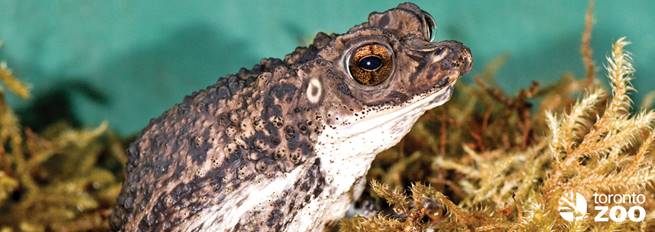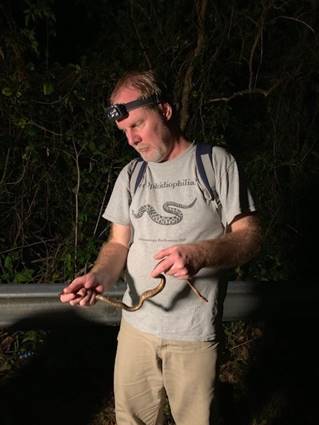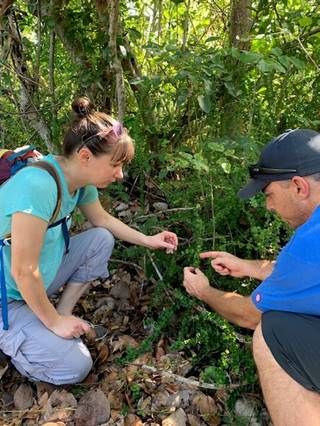
TORONTO ZOO’S PUERTO RICO FIELD WORK
IN SUPPORT OF CONSERVATION EFFORTS


(Left) Rick Vos and (Right) Laura Huculak, Toronto Zoo, in the field in Puerto Rico: Photo Credit, Toronto Zoo
The group travelled to El Tallonal, an established reintroduction site, where two artificial ponds have been constructed for the reintroduction of PRCT hatched in various AZA institutions. PRCT tadpoles were witnessed in the ponds. These tadpoles were determined to be produced from previously released tadpoles that are now wild toads and the group explored the habitat in search of adult toads. Successional forest growth taking over, following canopy loss from the hurricane two years ago, made it difficult to see the toads that are well hidden by the extra vegetation.
From there, the next leg of the research trip began at a new base on the southwest corner of the island, Combate Beach. It was an exciting moment in the trip as the group was scheduled to pick up a shipment of 193 juvenile PRCT that were produced using in vitro fertilization techniques. This was the first time PRCT were produced through in vitro techniques developed at the University of Mississippi and supported by AZA, the USFWS and the Department of Natural and Environmental Resources. These toads were part of an important research study to track their movement and dispersal after they were released at Los Conventos, a reintroduction site in Guayanilla. This is a rare release of metamorphosed toads, as PRCT are typically released as tadpoles. Some toads had small tracking devices affixed to them, while others were marked with a fluorescent powder.
The information gathered from the marked PRCT helped us to understand a more about dispersal patterns for the toadlets after they are released. It also served as a test to determine the effectiveness of the two different methods used for marking and tracking the toads. We found several of the released toads and both methods of marking and tracking proved effective.
“After working with the Zoo’s breeding population of PRCT for the past five years and sending thousands of tadpoles back to Puerto Rico for release, it was great to visit the island to see the results of our efforts,” says Rick Vos, Lead Keeper Amphibians & Reptiles, Toronto Zoo. “Meeting many of the collaborators in this ongoing recovery effort and witnessing the in situ components of the project was one of the highlights of my thirty-year zoo career. I’m very grateful to have had the opportunity to participate in this pioneering endangered species recovery program.”
The important field work conducted for PRCT was also accompanied by the group joining a PRCT working group meeting where various partners were able to present on the work they have been doing to support PRCT recovery at various locations on the island. Following the meeting, we visited the Tamarindo site where the original ephemeral ponds that supported the last breeding population of toads on the island were discovered decades ago. These ponds were essentially large puddles that filled up after the wet season. The toads would use them to breed in. At that time, the ponds were not protected, they were in the middle of a parking lot used by beach goers. Since then, the site has been closed off to vehicle traffic and a boardwalk has been built to protect the habitat and toads from foot traffic. Additional artificial ponds have also been constructed in the area to help with recovery efforts.
“One of my personal highlights from the field work in Puerto Rico was seeing the toads in their natural habitat, and knowing they could be descendants from the Toronto Zoo,” says Laura Huculak, Wildlife Care Keeper, Toronto Zoo. “Meeting the people in Puerto Rico committed to the recovery program was inspiring. Seeing people working together across the continent with the common goal of saving this important endangered species is one of the many reasons I became a Zoo Keeper.”
The SSP for the PRCT was developed, in part, to reintroduce the species back into the wild. The Toronto Zoo has been an active participant in the breeding program for over 30 years. We are proud to announce that, with the addition of this year's tadpoles, the Toronto Zoo has contributed a total of 157,286 PRCT that have been released back into the wild. The work accomplished with PRCT has shown us that it takes a long term, sustained commitment to a program like this to achieve success when recovering a species from the brink of extinction. The Toronto Zoo hopes to continue its effort to save this unique and endangered toad in the years to come.
For more information on the Puerto Rican crested toad breeding program,
Additional important conservation programs supported during the same week-long Puerto Rico research excursion:
- Mata de Plátano Field Station and Nature Reserve located on the north-central karst country just south of Arecibo. One of the highlights of the Reserve is an extensive cave system that serves as a home for native bats. The group visited the mouth of the cave in the evening to witness Puerto Rican Boas hunting for the bats as they fly in and out of the cave. The boas strategically perch on vegetation, or on the cave wall, waiting for bats to fly close enough that they can grab them out of the air.
- Then travelling to the north-western corner of the island near Quebradillas to survey for Puerto Rican Harlequin Butterflies and anoles at Merendero. This particular butterfly is an endangered species, once on the brink of extinction. The North Carolina Zoo and Fort Worth Zoo have been working with partners in Puerto Rico to find more areas where this rare butterfly still exists and try to figure out why it is so rare. It’s possible that native, and introduced anole lizards, are predating the butterfly larvae. To test this theory, the field work group caught several anoles in the area to conduct gastric washes for gut content analysis. Butterfly larvae, like all insects, periodically shed their exoskeletons (outer “skin” covering) to allow for growth, the exoskeleton does not grow with them. These exoskeleton moults were also collected from the butterfly larvae for genetic analysis to help determine if butterfly larvae were present in the lizard’s guts.
- The group travelled to El Yunque to visit Puerto Rico’s largest rainforest and tour the USFWS’ Puerto Rican Parrot Facility. The group met up with staff at the facility and learned about the incredible work they are doing there to recover this endangered parrot. Despite some setbacks from the hurricane two years ago, the breeding centre is doing well and had several parrots ready for release back into the wild.
- We also went to Rio Grande to conduct night surveys for the Virgin Island Boa. This snake is listed as endangered and restricted to only a few small sites on the eastern side of the island. The group managed to capture two Puerto Rican Boas, one Virgin Island Boa and identified a second Virgin Island Boa deceased on the road. Measurements and genetic samples were taken we and PIT tagged the live snakes before releasing them again for future monitoring.


Join us Sunday, January 26 for Australia Day to help provide support after the devastating effects the recent wildfires have had on Australia’s wildlife populations. It is estimated that over one billion animals’ lives have been lost during these fires and we want to support the many firefighters battling the flames and the wildlife care teams working tirelessly to save these animals and the forests they call home.
$1 from every admission on Australia Day will be donated to help support Australia in this difficult time. Proceeds will be going to Zoo and Aquarium of Australia (ZAA) Wildlife Conservation Fund to work towards the rescue and rehabilitation needs of affected wildlife, bringing together expertise, resources, equipment and facilities to help native animals in the crisis-affected areas.
For more information on Australia Day,







